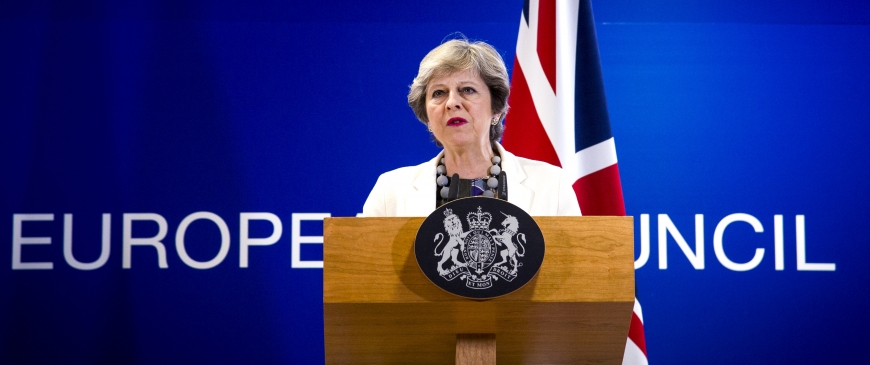
Theresa May can't afford red lines on Brexit
Pressure is growing on Theresa May to set out her Brexit plan. The EU’s insistence that for the duration of any transition phase Britain will remain subject to the bloc’s regulations and have no say over any new rules has enraged Brexiteers. Now the prime minister has to come up with an outline for a future relationship with the EU that her warring ministers can agree to rally behind. She still has a chance of getting a decent Brexit deal, but she will need to show the EU she’s willing to compromise on her red lines. Reaffirming her determination to leave the EU’s customs union in recent days does not bode well.
In the fog of confusion hanging over May’s government, the EU’s other 27 members can vaguely discern the shape of the future relationship she’ll seek. What is clear so far is that both models the European Commission has put on the table — “Canada,” which doesn’t satisfy Britain’s demands on services, or “Norway,” which crosses the UK’s red lines on free movement and Europen Court of Justice jurisprudence — are non-starters in Britain. May is likely to reject both and ask for a bespoke deal, based on a new model of regulatory alignment.
Needless to say, Germany, France and the Commission do not like what is emerging from the fog. They will tell May that her red lines on Norway make a Canada-style deal inevitable. Some EU governments think she could aspire to “Canada Plus” — the plus referring to more provisions on services — but only if she backs down from other demands.
British officials have hinted that a mechanism described in a recent report from the Institute for Government is close to their thinking. This would divide economic activity into three baskets: complete alignment, where the UK would follow EU rules; “managed mutual recognition,” where both would agree to common objectives but each would choose its own rules; and a third basket where the UK would do what it wanted.
Berlin, Paris and Brussels are likely to shoot down these not-yet-proposed ideas. They have repeatedly said they don’t want the UK to “cherry-pick” certain bits of the single market and leave aside the rest. EU governments also worry that they — given their diverging economic strengths and interests — could never agree on which sorts of business should go into each basket. Some fear that the UK’s baskets could even lead to a Swiss-type model, which they dislike.
Despite the opposition, some British officials are optimistic, noting that the 27 are more divided on the future relationship than they were on the first phase of the Brexit talks. And to some extent, they are right. Some governments, uncomfortable with the hard line taken by the Germans, French and the Commission, point out that the U.K.’s trade with the EU is eight times that of Canada’s and that Britain and the EU will want a much closer relationship in areas like security, foreign policy and research. This camp includes Sweden, the Netherlands, Denmark, Ireland, Portugal, Italy, Croatia, Hungary, Poland and possibly Spain.
But British officials should not expect such differences to make their bespoke model viable. The chances of London making any headway with it are slim.
The bottom line is that EU countries fear a bespoke deal would threaten the level playing field that they cherish. Those that want a softer deal want it to be softer in different ways and have no obvious leader.
All 27 understand that the EU will need to forge a common position on Brexit — and that Germany, France and the Commission usually get much of what they want. And the net recipients of EU funds will be reluctant to annoy Germany, the EU’s paymaster, as talks on a new budget cycle get underway this spring. There’s also a technical difficulty that may limit the scope of the Brexit deal: “Most favored nation” clauses mean the EU would have to upgrade its trade deals with other partners if it offers Britain better terms on services.
There is, however, a way for May to sidestep this opposition and win the argument for a broader deal than Germany, Paris and Brussels appear ready to consider. And there will, of course, be a price to pay.
To get such a deal, May will have to address the EU’s concerns on the level playing field by swallowing rigorous dispute resolution mechanisms.
She will also need to be flexible on her “red lines,” such as accepting ECJ authority in some areas. How the U.K. chooses to reduce EU migration will matter: A system giving Europeans a smoother entry to the UK than non-EU nationals — which the Home Office appears to be planning — could generate much goodwill. So would the offer of money for particular EU projects, or indeed the general budget.
The EU’s official position is that it will not “sell” market access to the UK. But Brexit creates a €12 billion annual deficit in the EU budget and some European officials are now hinting that they would welcome British contributions.
May’s red lines on regulatory sovereignty could prove the hardest to dilute. For many Conservatives, Brexit means “taking back control” and thus rejecting all EU rules. Indeed, hard Brexiteers in her Cabinet are making it exceedingly difficult for her to appear to accept any type of EU oversight or obligation post Brexit.
But, as a top French official put it: The UK needs to understand that its future relationship by definition will be a “trade-off between rules and access.”
The time is fast approaching for May to lift the fog by telling the 27 how much she will prioritize sovereignty against economic well-being.
Charles Grant is director of the Centre for European Reform.
